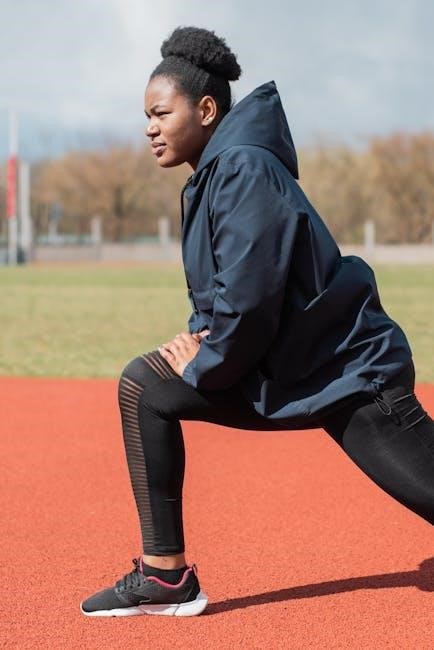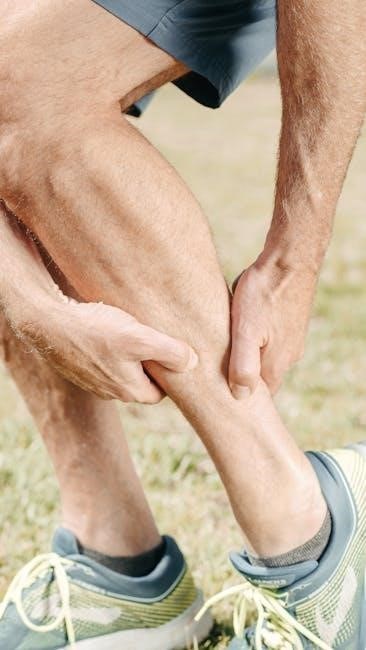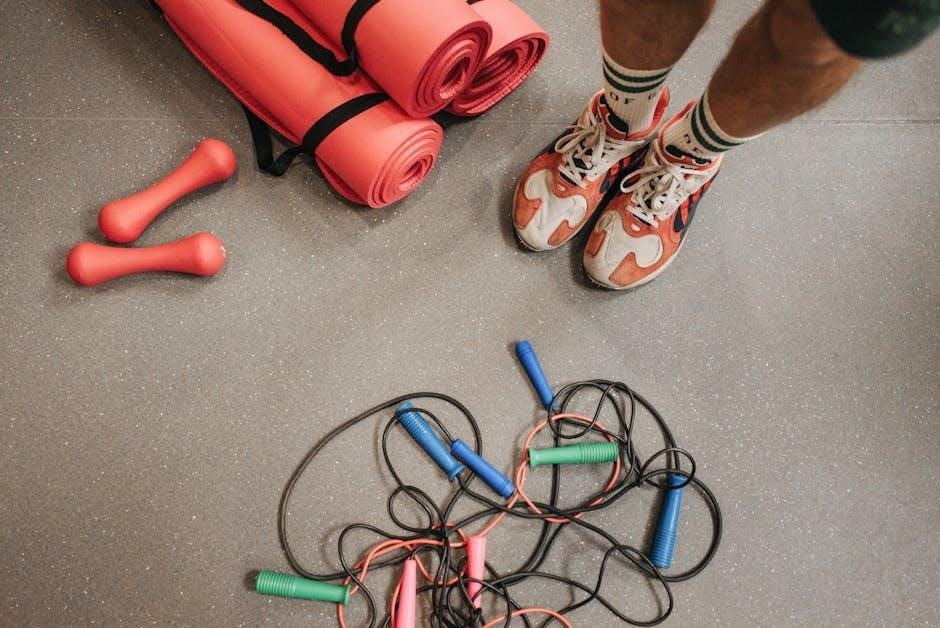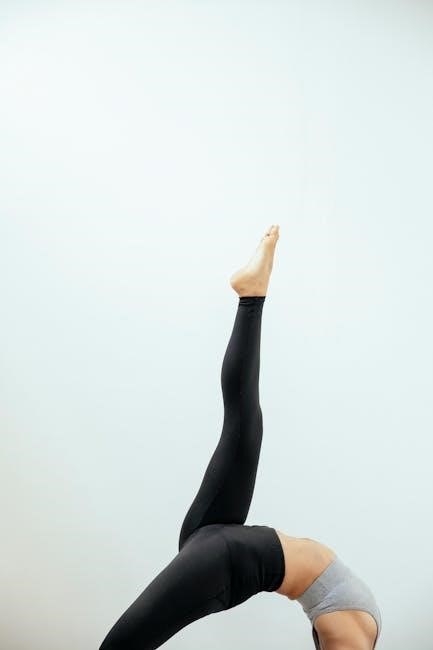Cable leg workouts offer a versatile and efficient way to target lower body muscles‚ providing constant tension for enhanced engagement. They suit all fitness levels‚ from beginners to advanced lifters‚ and are easily integrated into various training splits. With access to downloadable PDF guides‚ you can plan and track your progress effectively‚ ensuring a balanced and structured approach to leg development.
1.1 What Are Cable Leg Workouts?
Cable leg workouts are exercises that utilize cable machines to target the muscles of the lower body. These machines provide adjustable resistance through a system of pulleys and cables‚ allowing for a wide range of movements. From squats and deadlifts to kickbacks and leg curls‚ cable machines enable precise targeting of specific muscle groups. They offer the advantage of constant tension throughout the exercise‚ which can enhance muscle engagement. Cable leg workouts are versatile‚ catering to both beginners and advanced lifters‚ and can be tailored to focus on strength‚ hypertrophy‚ or endurance. With the availability of downloadable PDF guides‚ users can access structured workout plans‚ making it easier to design and track progress. This approach ensures a balanced and effective way to develop leg strength and muscle definition‚ whether in a gym or home setup.
1.2 Benefits of Incorporating Cable Machines into Leg Training
Incorporating cable machines into leg training offers numerous benefits‚ including consistent muscle engagement and improved targeting of specific muscle groups. Unlike free weights‚ cable machines provide constant tension throughout the exercise‚ which can enhance muscle activation and growth. They also allow for a wide range of movements‚ making it easier to isolate or emphasize different areas‚ such as the quadriceps‚ hamstrings‚ or glutes. Additionally‚ cable machines are space-efficient and versatile‚ offering multiple exercises with a single piece of equipment. This convenience‚ combined with the availability of downloadable PDF workout plans‚ makes it easier to structure and track progress. By leveraging cable machines‚ individuals can achieve a balanced and effective leg workout‚ whether focusing on strength‚ hypertrophy‚ or overall lower body development.
1.3 How Cable Machines Differ from Free Weights for Leg Exercises

Cable machines and free weights differ significantly in how they apply resistance during leg exercises. Cable machines provide constant tension throughout the movement‚ which can enhance muscle engagement and minimize the need for stabilizer muscles. In contrast‚ free weights rely on gravity‚ resulting in varying resistance levels throughout the exercise. Cable machines also allow for controlled‚ precise movements‚ reducing the risk of injury and making them ideal for isolation exercises. Free weights‚ however‚ promote functional strength and muscle coordination‚ as they require engagement of stabilizer muscles. Both tools are effective but serve different purposes. Cable machines are particularly advantageous for targeting specific muscle groups‚ while free weights build overall strength and athleticism. Understanding these differences helps in choosing the right equipment for specific training goals‚ ensuring a well-rounded leg workout routine.
Essential Cable Leg Exercises
Cable leg exercises target multiple muscle groups‚ improving strength‚ balance‚ and muscle definition. They include goblet squats‚ pull-throughs‚ kickbacks‚ deadlifts‚ hip adductions‚ abductions‚ and standing leg curls‚ suitable for all fitness levels.
2.1 Cable Goblet Squat
The Cable Goblet Squat is a highly effective exercise for targeting the quadriceps‚ hamstrings‚ and glutes. It involves holding a cable handle close to the chest while performing a squat‚ maintaining proper form to ensure muscle engagement. This exercise is excellent for building lower body strength and improving balance. By adjusting the cable height and resistance‚ it can be tailored to suit different fitness levels. The constant tension from the cable enhances muscle activation‚ making it a valuable addition to any leg workout routine. Additionally‚ the goblet squat position helps maintain a upright posture‚ reducing the strain on the lower back. For optimal results‚ focus on controlled movements and full range of motion. This exercise is particularly beneficial for those looking to strengthen their legs without relying solely on free weights.
2.2 Cable Pull-Through
The Cable Pull-Through is an excellent exercise for targeting the glutes and hamstrings‚ with minimal involvement of the lower back. It involves standing facing a cable machine with the cable set at hip height‚ using a rope or strap handle. By bending at the hips and knees‚ you pull the cable through your legs‚ squeezing your glutes at the end of the movement. This exercise is particularly effective for isolating the posterior chain muscles‚ promoting muscle growth and improved athletic performance. Proper form is crucial to avoid strain‚ ensuring the movement is smooth and controlled. The Cable Pull-Through is versatile‚ allowing for adjustments in resistance to suit different fitness levels. It is also beneficial for those looking to enhance hip extension strength without the need for heavy loading. Incorporating this exercise into your leg workout routine can lead to significant gains in glute and hamstring development.
2.3 Cable Kickback
The Cable Kickback is a highly effective exercise for targeting the glutes‚ particularly the gluteus maximus‚ while also engaging the hamstrings. It is performed by standing facing away from a cable machine with the cable set at ankle height. Using a rope or strap attachment‚ you hinge at the hips and knees‚ then extend your hips and push the cable backward‚ squeezing your glutes at the peak of the movement. This exercise is excellent for isolating the glutes with minimal lower back involvement. Proper form is essential to avoid strain‚ ensuring a smooth‚ controlled motion throughout the range of motion. The Cable Kickback is versatile‚ allowing for adjustments in resistance and foot positioning to target different areas of the glutes. It is particularly beneficial for those looking to enhance hip extension strength and improve muscle definition. Incorporating this exercise into your routine can lead to significant improvements in glute development and overall lower body aesthetics.

2.4 Cable Deadlift
The Cable Deadlift is a powerful exercise that targets the hamstrings‚ glutes‚ and lower back muscles. It is performed by standing facing a cable machine with the cable set at floor level; Using a straight bar or rope attachment‚ you hinge at the hips and knees to grip the cable‚ then lift the weight by extending your hips and knees‚ keeping the back straight and core engaged. This exercise mimics the movement of a traditional deadlift but with the added benefit of constant tension from the cable. Proper form is crucial to avoid injury‚ emphasizing a neutral spine and controlled movement throughout the range of motion. The Cable Deadlift is an excellent addition to any leg workout‚ as it effectively engages multiple muscle groups simultaneously‚ promoting strength and hypertrophy. It is particularly beneficial for those looking to improve posterior chain development and overall lower body power.
2.5 Cable Hip Adduction

The Cable Hip Adduction is an effective exercise for targeting the adductor muscles of the thighs. It is performed by sitting at a cable machine with the legs spread apart and the cable attached to the ankles or a strap around the thighs. The movement involves pulling the legs together against the resistance of the cable‚ squeezing the adductors at the top of the movement‚ and then slowly returning to the starting position. This exercise helps improve muscle balance‚ enhance athletic performance‚ and strengthen the inner thighs. Proper form is essential to avoid strain‚ with a focus on controlled movements and full engagement of the target muscles. The Cable Hip Adduction is a valuable addition to any leg workout routine‚ particularly for those looking to address muscle imbalances or enhance functional strength. It can be adjusted with different weights and repetitions to suit various fitness levels and goals.
2.6 Cable Hip Abduction
The Cable Hip Abduction is a highly effective exercise for targeting the gluteus medius and other hip abductor muscles. It is performed by standing or sitting at a cable machine with the cable attached to the ankles or a strap around the thighs. The movement involves lifting the legs outward‚ away from the midline of the body‚ against the resistance of the cable. This exercise is excellent for improving muscle balance‚ enhancing functional strength‚ and addressing issues like poor posture or uneven gait. Proper form is crucial‚ with a focus on controlled movements and full engagement of the abductors. The Cable Hip Abduction is a versatile exercise that can be adjusted to suit different fitness levels by modifying the weight‚ repetitions‚ and range of motion. It is a valuable addition to any leg workout routine‚ particularly for those looking to strengthen the outer thighs and improve overall lower body stability;
2.7 Cable Standing Leg Curl
The Cable Standing Leg Curl is an excellent exercise for targeting the hamstrings‚ particularly the biceps femoris‚ as well as the gastrocnemius and soleus muscles in the calves. It is performed by standing in front of a cable machine with the cable attached to the back of the ankles. The movement involves bending the knees to curl the heels toward the glutes‚ maintaining control throughout the entire range of motion. This exercise is beneficial for improving hamstring flexibility‚ strength‚ and overall lower body functionality. Proper form is essential to avoid strain on the knees‚ with a focus on smooth‚ controlled movements. The Cable Standing Leg Curl can be adjusted to suit different fitness levels by modifying the resistance and repetition range. It is a valuable addition to any leg workout routine‚ particularly for those looking to enhance athletic performance and everyday mobility.

Advanced Cable Leg Workout Techniques
Enhance your leg workouts with reverse-pyramid protocols‚ Romanian deadlifts‚ and knee-joint exercises. These techniques maximize muscle engagement‚ improve form‚ and target hamstrings‚ glutes‚ and calves effectively for advanced lifters.
3.1 Reverse-Pyramid Protocol for Maximum Muscle Engagement
The reverse-pyramid protocol is a highly effective training method that allows you to maximize muscle engagement during cable leg workouts. By starting with heavier weights and lower repetitions‚ you target fast-twitch muscle fibers‚ which are crucial for strength and hypertrophy. As you progress through the workout‚ you gradually reduce the weight while increasing the number of repetitions‚ ensuring that both endurance and pump are achieved. This approach not only enhances muscle growth but also improves overall lower body strength. Incorporating this protocol into your cable leg routine can lead to significant gains‚ especially when combined with proper form and consistent progression. It’s a versatile technique that can be applied to exercises like cable deadlifts‚ pull-throughs‚ and goblet squats‚ making it a cornerstone of advanced training strategies.
3.2 Incorporating Romanian Deadlifts for Hamstring and Glute Focus
Romanian Deadlifts (RDLs) are a powerful exercise for targeting the hamstrings and glutes‚ particularly the upper region where the glutes and hamstrings connect. This exercise is especially effective when performed with cable machines‚ as it allows for consistent tension throughout the movement. To execute an RDL‚ start by standing facing a cable machine with the cable set at a low position. Hinge at the hips‚ keeping your back straight‚ and pull the cable toward your glutes‚ squeezing at the top of the movement. Focus on slow‚ controlled reps to maximize muscle engagement. RDLs are versatile and can be adjusted by changing the weight or rep range‚ making them suitable for both beginners and advanced lifters. Incorporating this exercise into your cable leg workout routine can significantly enhance hamstring and glute development‚ providing a strong foundation for overall lower body strength.
3.3 Adding Knee-Joint Hamstring and Calf Exercises
Incorporating knee-joint hamstring and calf exercises into your cable leg workout enhances overall lower body development. Cable standing leg curls are ideal for targeting the hamstrings‚ focusing on the knee joint. To perform‚ stand facing the cable machine with the cable at a low setting‚ then curl your heels toward your glutes‚ maintaining control throughout the movement. For calf exercises‚ seated or standing calf raises using a cable machine are effective. These exercises strengthen the gastrocnemius and soleus muscles‚ improving ankle mobility and lower leg aesthetics. Adjusting the weight and reps according to your fitness level ensures progressive overload. Combining these exercises with others‚ like Romanian deadlifts‚ creates a comprehensive leg workout. Printable PDF guides can help you structure and track these exercises‚ ensuring balanced muscle growth and functional strength.

Structuring Your Cable Leg Workout
Cable leg workouts can be integrated into full-body‚ push-pull-legs‚ or upper-lower splits. Downloadable PDF guides provide structured plans‚ ensuring balanced development and easy tracking of progress for all fitness levels.
4.1 Full-Body Workout Integration
Integrating cable leg exercises into a full-body workout enhances overall muscle balance and efficiency. By combining lower body movements like cable goblet squats and pull-throughs with upper body exercises‚ you can target multiple muscle groups in a single session. This approach is ideal for those with limited time‚ as it promotes comprehensive development without isolating muscle groups. Printable PDF guides offer structured routines‚ ensuring each workout is well-rounded and progressive. Additionally‚ incorporating core-strengthening exercises alongside cable leg work further improves stability and overall athleticism. This holistic method not only maximizes time but also supports long-term fitness goals‚ making it a popular choice among fitness enthusiasts seeking a balanced physique.
4.2 Push-Pull-Legs (PPL) Split Routine
The Push-Pull-Legs (PPL) split is a popular training method that divides workouts into three categories: push exercises‚ pull exercises‚ and leg exercises. Cable leg workouts seamlessly integrate into this routine‚ allowing for focused lower body development. By dedicating one day to legs‚ you can prioritize exercises like cable goblet squats‚ pull-throughs‚ and deadlifts‚ ensuring comprehensive muscle engagement. This split is ideal for those seeking balanced development‚ as it allows for adequate recovery time between sessions. Printable PDF guides provide structured plans‚ making it easy to organize and track your progress. Incorporating cable exercises into the PPL format enhances efficiency‚ ensuring each leg workout is both challenging and effective. This approach is particularly beneficial for individuals aiming to build strength and muscle mass while maintaining a balanced physique.
4.3 Upper-Lower Split for Balanced Development
The Upper-Lower split is a training approach that alternates between upper body and lower body workouts‚ allowing for balanced development. Cable leg exercises fit perfectly into this structure‚ as they provide targeted stress to the lower body muscles without overtaxing the upper body. This split is ideal for those seeking overall muscle balance and symmetry. By dedicating specific days to lower body training‚ you can focus on exercises like cable deadlifts‚ pull-throughs‚ and hip abductions‚ ensuring comprehensive leg development. Printable PDF guides offer structured plans‚ making it easy to organize and track your progress. This method is particularly effective for individuals aiming to build strength and muscle mass while maintaining a balanced physique. The Upper-Lower split is a versatile and efficient way to incorporate cable leg workouts into your routine.

PDF Resources for Cable Leg Workouts
Downloadable PDF guides provide structured workout plans‚ exercise demos‚ and progress-tracking sheets. These resources help organize and maximize the effectiveness of your cable leg training routine.
5.1 Downloadable Cable Leg Workout Plans
Downloadable PDF plans offer comprehensive routines tailored to specific goals‚ such as glute-focused or full-leg development. These guides often include detailed exercise instructions‚ sets‚ reps‚ and progression strategies. Many plans feature photo demos‚ making it easier to master proper form. Customizable templates allow users to track workouts week-by-week‚ ensuring accountability and progress. Whether you’re aiming for strength‚ hypertrophy‚ or functional mobility‚ these plans provide a clear structure. They cater to all fitness levels‚ from beginners to advanced lifters‚ and can be integrated into various training splits like PPL or Upper-Lower. Printable formats make them convenient for gym or home use‚ helping you stay organized and motivated. These resources are invaluable for anyone seeking a structured approach to cable leg training.
5.2 Printable PDF Guides for Tracking Progress
Printable PDF guides are essential tools for monitoring progress in cable leg workouts. These resources often include customizable templates for logging exercises‚ weights‚ and repetitions. By tracking each session‚ users can identify patterns‚ celebrate milestones‚ and adjust routines as needed. Many guides also provide space for setting and revisiting fitness goals‚ enhancing motivation and accountability. Additionally‚ some PDFs incorporate nutritional advice and recovery tips to support overall leg development. The ability to print these guides makes them convenient for gym or home use‚ allowing users to stay organized and focused. Over time‚ these records serve as a visual reminder of progress‚ helping to maintain consistency and drive. Such tools are invaluable for anyone committed to maximizing the effectiveness of their cable leg training regimen.

Tips for Maximizing Your Cable Leg Workout
Adjust weights and reps to suit your fitness level‚ maintain proper form to prevent injuries‚ and incorporate variations to keep your muscles engaged and challenged consistently.
6.1 Adjusting Weight and Repetitions for Optimal Results
Properly adjusting the weight and repetitions is crucial for maximizing the effectiveness of your cable leg workout. Start with a weight that allows you to complete the desired number of reps with good form‚ gradually increasing the load as your strength improves. For hypertrophy‚ aim for 3-4 sets of 8-12 reps‚ while higher reps (12-15) are ideal for endurance. Lower reps (4-6) with heavier weights can enhance strength. Ensure progressive overload by incrementally increasing weight or reps over time to continue challenging your muscles. Refer to your PDF guide for structured sets and reps tailored to your fitness goals‚ ensuring a balanced and progressive approach to leg development.

6.2 Maintaining Proper Form to Prevent Injury
Maintaining proper form during cable leg workouts is essential to prevent injuries and ensure effective muscle engagement. Always engage your core to stabilize your body and maintain a neutral spine. For exercises like cable goblet squats‚ keep your chest upright and knees in line with your toes. During cable pull-throughs‚ avoid rounding your back and focus on squeezing your glutes. Ensure full range of motion without sacrificing form for heavier weights. Avoid letting the cable snap back‚ as this can cause unnecessary strain. Use a slow and controlled tempo‚ especially during eccentric phases‚ to minimize stress on joints. Proper form not only prevents injuries but also ensures that the target muscles are effectively activated. Refer to your PDF guide for detailed form cues and adjustments to maximize safety and results.
6.3 Incorporating Variations for Muscle Confusion
Incorporating variations into your cable leg workout is crucial for avoiding plateaus and ensuring continuous progress. By altering exercises‚ angles‚ and techniques‚ you can challenge your muscles in new ways‚ promoting balanced development. For example‚ switching from a high cable setting to a low one can shift the focus from quads to hamstrings in exercises like cable goblet squats. Using different attachments‚ such as rope or v-handles‚ can also modify the emphasis on specific muscle groups. Additionally‚ varying the tempo of your reps‚ such as slowing down the eccentric phase‚ can increase time under tension and enhance muscle engagement. Techniques like drop sets or supersetting cable exercises with free-weight movements can further add variety. These variations not only prevent muscle adaptation but also keep your workouts engaging and effective‚ ensuring long-term gains. Your PDF guide provides detailed variations to keep your leg training dynamic and progressive.

Cable leg workouts are a powerful tool for building strength and definition. Consistency and progressive overload are key to achieving lasting results and a well-rounded physique.
7.1 Summarizing the Effectiveness of Cable Leg Workouts
Cable leg workouts are highly effective for building strength‚ muscle size‚ and mobility in the lower body. They provide constant tension throughout exercises‚ enhancing muscle engagement and promoting balanced development. Cable machines are versatile‚ catering to all fitness levels‚ and can be easily incorporated into various training splits‚ such as Push-Pull-Legs or Upper-Lower routines. Their ability to isolate specific muscle groups‚ like the hamstrings or glutes‚ makes them ideal for targeted training. Additionally‚ the availability of downloadable PDF guides ensures structured planning and progress tracking. Consistency and progressive overload are key to maximizing results‚ making cable leg workouts a valuable addition to any fitness regimen. They offer a practical and efficient way to achieve a strong‚ defined lower body‚ whether in a gym or home setting.
7.2 Encouraging Consistency and Progression
Consistency is the cornerstone of achieving lasting results with cable leg workouts. Regular training ensures continuous muscle engagement and strength gains. Progression is equally vital; gradually increasing weight or repetitions challenges muscles‚ preventing plateaus. Printable PDF guides can help track workouts‚ providing clear goals and motivation. Staying committed to a structured routine‚ whether following a Push-Pull-Legs split or Upper-Lower format‚ fosters discipline and accountability. Celebrating small milestones enhances motivation‚ keeping you focused on long-term objectives. By maintaining dedication and progressively overloading muscles‚ individuals can unlock their full potential‚ achieving a stronger‚ more defined lower body. Consistency and progression are not just strategies—they are the keys to sustained success in any cable leg workout journey.
